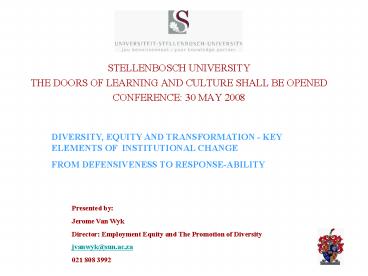STELLENBOSCH UNIVERSITY PowerPoint PPT Presentation
1 / 9
Title: STELLENBOSCH UNIVERSITY
1
- STELLENBOSCH UNIVERSITY
- THE DOORS OF LEARNING AND CULTURE SHALL BE OPENED
- CONFERENCE 30 MAY 2008
DIVERSITY, EQUITY AND TRANSFORMATION - KEY
ELEMENTS OF INSTITUTIONAL CHANGE FROM
DEFENSIVENESS TO RESPONSE-ABILITY
Presented by Jerome Van Wyk Director Employment
Equity and The Promotion of Diversity jvanwyk_at_sun.
ac.za 021 808 3992
2
LOOKING THROUGH THE LENS OF INTERSECTIONALITY OF
TRANSFORMATION
- INTERSECTIONALITY Explores and addresses
conflicting personal, cultural, gender,
ability/disability, class and political factors
that explain and critique conflicting experiences
and interests - both between and within
privileged and disadvantaged groups
3
THE TRINOCULAR LENS OF TRANSFORMATION
Legislative Compliance Lens
Human Rights Social Justice Lens
Trinocular Lens approach
Business-Case Lens
- Structural and institutional barriers to
substantive equality and transformation such as
language , curriculum content and cultural
alienation, matters far more than crude racism
and sexism however distressing the latter may be
4
THE PERVASIVENESS OF STRUCTURAL INSTITUTIONAL
INEQUALITY
- LEGISLATIVECOMPLIANCE LENS
It is not easy at an individual level, despite
current progressive labour legislation or even
policy guidelines for affirmative action and
diversity management.
- HUMAN RIGHTS- SOCIAL JUSTICE LENS
Replacing the colour / gender of roleplayers
(even in high-profile positions) is not
sufficient to change institutional barriers. Many
black staff / women are often compliant /
complicit in maintaining the status quo - hence
no meaningful, substantive change
- BUSINESS-CASE LENS
Diversity is a strength, not a problem. Diversity
strengthens relationships and enriches the
educational experience. It promotes collective
growth and productivity. Diversity enhances the
universitys academic competitiveness.
5
INTERSECTIONALITIES OF TRANSFORMATION AND
EQUITY/DIVERSITY PRACTICES
Remark
Our racial, gender, ability and class identities
are usually not only about how we perceive and
identify ourselves but also how others identify
us (ab)using our specific, yet differential and
changing geographical, cultural and historical
locations
IDEAL INSTITUTIONAL CULTURE
Ideally transformation practices ought to
facilitate a sense of homeliness and us-ness in
contrast to them-ness
TRANSFORMATION PRATICES (OUTCOMES)
Ideally equity and diversity practices ought to
sensitize people to develop emotional and
cultural intelligence. It is also about
strategic response-ability and relating with an
open eye / I
(INPUTS) EQUITY AND DIVERSITY PRACTICES
6
THE UNHOMELY/ HOMELY SIDE OF SU INSTITUTIONAL
CULTURE
TRANSFORMATION PRACTICES
TRANSFORMATION BARRIERS
THE TROUBLE WITH SU INSTITUTIONAL CULTURE
FROM GENESIS TO ARTICULATION
Hierarchicization Complicity/compliance
- Systemic expressions of 1,2,3, rooted in group
interests and traditional organisational
formations of committees, appointments and
promotions processes. Consolidating unhomely
spaces. - Behaviour rooted in the lack of political will
and refusal to integrate differences. Destructive
othering of people. - Power rooted in Whiteness, Maleness,
Afrikaans-ness, Middle class-ness - 1. Privilege rooted in the legacy of continued /
patterned socio-historical consciousness
(mindset).
- Conscious/unconscious complicity and compliance
between - Coloured white staff who are
Afrikaans-speaking. - Women men who operate at similar levels of
appointment eg leadership positions. - White Afrikaans-speaking women and white
Afrikaansspeaking men.
- Race
- Gender
- Ability
- Language
- Levels of
- appointment
- Economic class
7
THE UNHOMELY/ HOMELY SIDE OF SU INSTITUTIONAL
CULTURE
EQUITY/DIVERSITY PRACTICES
THE TROUBLE WITH SU EQUITY/DIVERSITY PRACTICES
Structural inequality is deeper and more damaging
to relationship building, collective growth,
productivity and academic competitiveness than
overt forms of racism and sexism
- Lack of a clear long-term Transformation Plan
- Negative experiences of Black and female
students and staff. Many staff remain
silent and frustrated. Those who are more
resourceful and therefore marketable end up
exiting the system. - Alienation of students i.t.o. the language of
instruction. Unhomely spaces of us-ness in
relation tothem-ness. - Alienation of Black staff i.t.o. language used
in institutional documentation , staff meetings,
committee work. - Dominance of the number of White male staff at
all levels despite significant changes in student
demographics. - White males still dominate knowledge production
and research output and therefore remain ahead of
queue. - Insensitivity and ignorance among
historically-privileged staff regarding the
Black, Female and Non-Christian experience.
8
FROM DEFENSIVENESS TO RESPONSIVENESS
DEVELOP RESPONSEABILITY !
- Develop a clearly articulated Transformation
(not just EE) Plan, with objectives and
strategies for reaching them. (Currently staff
across the race/gender lines do not believe that
transformation is a well planned and managed
process. This leads to anxiety, misconceptions
and resistance). - The university leadership (with a forum of
academic and support staff trade union reps)
should develop a shared and coherent vision of
transformation. - The Transformation Plan should not only address
employment equity issues but must include - The full range of transformation challenges
especially - those related to structural
inequality.
continue
9
- The creation of a shared values document
which articulates concrete strategies. - A code of conduct in order to address all
employees fears and anxieties.
- Communicate transformation processes/outcomes
continuously indicating what progress has been
made. - Communicate and talk more positively about
transformation pointing to its benefits rather
than its losses. Use a variety of modalities to
do this departmental meetings, faculty exec
meetings, discussion fora, newsletters, posters,
etc. - Appoint a dedicated manager for transformation
to drive the process to liaise closely with the
leadership and Rectors Management Team down to
the trade unions. - Provide generous resources (financial and
others) to ensure that this project succeeds. - Ensure that there will be consequences for
non-compliance and/or lack of tangible progress
and development.

